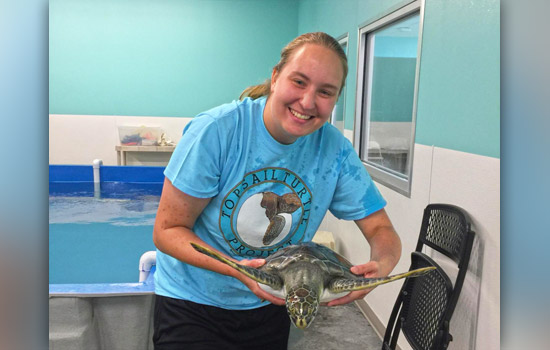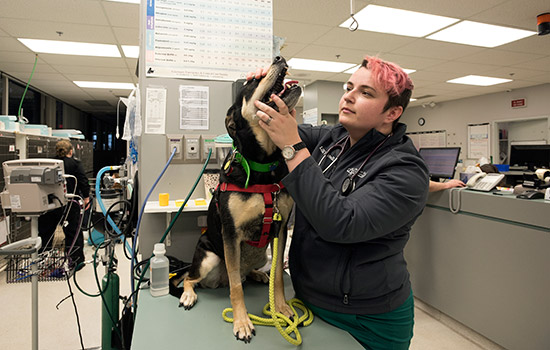Pre-vet program targets small, dedicated group
A. Sue Weisler
Liliya Becktell ’11 (photography, communications) returned to RIT in 2015 specifically for pre-vet preparation. She will begin at Cornell University College of Veterinary Medicine this fall.
RIT students interested in veterinary school face a rigorous application process akin to the requirements of medical school. These students rely upon the Pre-Veterinary Advisory Program to help them pursue graduate education in animal medicine.
The pre-vet program is housed in the College of Science and is open to students from any major. Program director Larry Buckley works mostly with students majoring in biology, which offers a curriculum that fulfills veterinary school requirements. The pre-vet group at RIT typically fluctuates between 10 to15 students, and each year one to three seniors apply to veterinary school.
For the past 15 years, Buckley, associate professor and head of RIT’s Thomas H. Gosnell School of Life Sciences, has seen his students go to veterinary programs at Cornell University, Michigan State, Tufts University, University of Pennsylvania, Ohio University, Ohio State, North Carolina, Purdue University, University of Illinois, University of Florida and the University of Guelph in Canada.
There are 30 vet schools in the United States that offer four-year doctoral programs in veterinary medicine and accept between 100 to 120 incoming students every year.
“It’s an urban myth that it’s harder to get into vet school than med school,” Buckley said. “That has never been true and it will never be true because there are 10 to 20 times more students who want to be medical doctors than veterinarians.”
That is not to say it’s easy to get into veterinary school. Pre-vet students face similar hurdles as their pre-med counterparts.
Buckley coaches his students to focus on three main components of their application: maintaining a high grade point average, preparing for the GRE exam, and accruing at least 1,000 hours of animal care under the supervision of a veterinarian. That number equates to about three summers worth of experience, Buckley said. The pre-vet program can help students find internships around the country or locally at the Seneca Park Zoo and Rochester Animal Services.
“I tell students if they want to know whether or not they are going to be happy being a veterinarian, they need to go to work there for about six months and they will find out real quick,” he said. “They are assisting veterinarians there in a very integral fashion.”
The Pre-Vet Club also helps students learn more about their chosen profession.
Kristen Swerzenski ’17 (biology) is the former vice president of the club. Being active with the group confirmed her decision to pursue her interest in marine veterinarian care. Swerzenski completed an internship at the Karen Beasley Sea Turtle Rescue and Rehabilitation Center in North Carolina. She is currently taking the year off to strengthen her vet school application with additional animal care experience.
Former Pre-Vet Club President Liliya Becktell ’11 (photography, communications) returned to RIT in 2015 specifically for the pre-vet preparation under Buckley’s guidance.
“My first experience at RIT was so amazing that there was no way I’d rather go anywhere else than back to RIT,” Becktell said.
She used her connections as an internal medicine animal care assistant at Veterinary Specialists and Emergency Services to add value to the vet club. Becktell arranged for students to tour the specialty hospital and invited veterinarian Dr. Kim Dodge to conduct a suture lab at RIT.
“We practiced on bananas and pork hocks,” Swerzenski said.
Research Becktell conducted with Buckley on canine spleen cancer has inspired her to pursue a D.V.M. and a Ph.D.
Cornell University College of Veterinary Medicine accepted Becktell for this fall semester, and she was awarded a 10-week funded summer research fellowship with her graduate school mentor.
“Veterinary school is very visceral,” Buckley said. “I tell students veterinarians put their hands where most people with good sense know not to.”
The personal essay is a critical part of the application. Veterinary schools want to know that students have thought deeply not just about working with animals but also the interactions with the clients, Buckley said.
Veterinarians are confronted with a myriad of issues, he added, such as when people walk in without money and want their dog back after surgery or never return for them.
Becktell’s experience working in animal emergency medicine has introduced her to the emotional side of animal care.
“I saw a lot of trauma, a lot of euthanasia,” Becktell said. “Every day I left exhausted and tired to the bone, but I’d wake up the next morning ready to go back.”
 Kristen Swerzenski ’17 (biology) completed an internship at the Karen Beasley Sea Turtle Rescue and Rehabilitation Center in North Carolina. She plans to apply to veterinary school.
Kristen Swerzenski ’17 (biology) completed an internship at the Karen Beasley Sea Turtle Rescue and Rehabilitation Center in North Carolina. She plans to apply to veterinary school.










